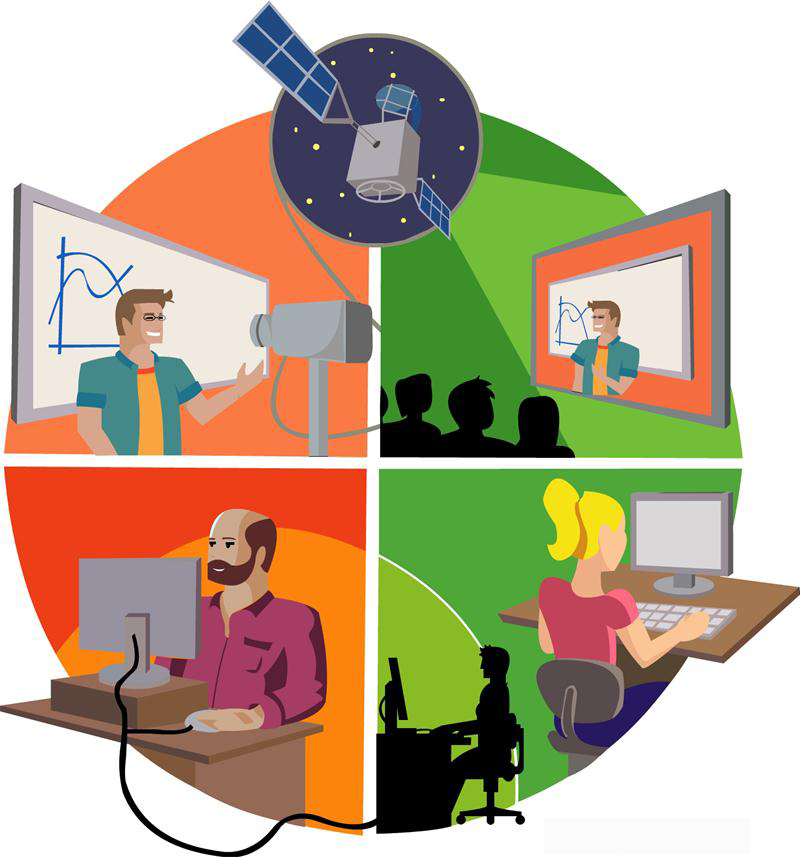Difference between E-learning and Distance Learning
Distance learning and e-learning both provide viable educational alternatives for busy adult learners. While the two terms often seem interchangeable and possess some similarities, they also have strategic although subtle differences. Here we'll take a look the differences between (and advantages of) e-learning and distance learning. Before knowing the main difference between e-learning and distance learning, we’ll also show you what is e-learning and what is distance learning.
What Is E-learning?
eLearning is the use of technology to enable people to learn anytime and anywhere. e-learning can include preparing, the delivery of without a moment to spare information and guidance from experts.
If you could stop time and inexpensively unite most of the people in your affiliation who need to learn and the resources to teach them, you would not need eLearning. In the real world, people have occupations to do, and budgets are limited. You're learning system will need the power of technology to overcome the impediments of time, distance, and resources.
You realize that people learn in a wide range of courses and at different times. To help these different learning needs, you will need different e-learning delivery methods. Furthermore, you will need a way to deal with develop and manage e-learning.

What Is Distance Learning?
Distance learning is the thing that should happen if the excellent idea has been taken in regards to the course design, instructional systems, correspondence mediums, and affiliation and authoritative issues related to the distance preparing program. Data exchange should come to pass regardless of the way that the educator and student are geologically isolated by time or distance.

E-learning vs Distance Learning: What’s the Differences?
Main Benefits of E-learning:
E-learning has definite benefits over conventional classroom preparing. While the most evident is the flexibility and the cost reserve stores from not traveling or spend excess time a long way from work, there are also others that won't be so self-evident. For example:
It's less expensive to produce - Using Trainer Soft's written work software to create your own specific nonconcurrent preparing programs, e-preparing is free once you reach the break-even point. Synchronous projects will have continued expenses associated with the educator dealing with the class, however, will even now be lower than standard courses.
It's self-paced - Most e-learning tools can be taken when needed. The "books" that you set up using Trainersoft create a module-based design enabling the learner to experience smaller pieces of preparing that can be utilized and absorbed for quite a while before proceeding forward.
It moves faster - According to an article by Jennifer Salopek in "Preparing and Development Magazine," e-learning courses progress up to 50 percent faster than conventional courses. This is most of the way because the individualized approach enables learners to skip material they already know and understand and move onto the issues they need preparing on.
It provides a consistent message - E-learning eliminates the problems associated with different educators teaching barely different material on the same subject. For association based preparing, this is often fundamental.
It can work from any area and whenever - E-learners can experience instructional meetings from anywhere, typically whenever. This Just-In-Time (JIT) benefit can make learning possible for people who never would have been able to work it into their schedules preceding the development of e-learning. (On the off chance that you manage a corporate learning program, however, be careful about requesting that workers learn without anyone else time from home.)
It can be updated easily and quickly - Online e-learning sessions are exceptionally easy to keep in the current style because the updated materials are uploaded to a server. Plate ROM-based projects may be barely more expensive to update and distribute, yet at the same time come out cheaper than reprinting manuals and retraining educators.
It can lead to increased retention and a stronger handle on the subject - This is because of the numerous elements that are combined in e-learning to reinforce the message, for example, video, sound, quizzes, interaction, etc. There is more over the ability to revisit or replay sections of the preparation that won't have been clear the first time around. Attempt that in a crowded lobby!
It can be easily managed for large gatherings of students - Trainersoft Manager permits corporate preparing directors, HR managers, and others to keep track of the course offerings, schedule or permit preparing for employees and keep tabs on their development and results. Managers can review a student's scores and identify any areas that need extra preparing.
There are many advantages to e-learning, and even the potential disadvantages (i.e., exhausting text-based courses, technophobia, loneliness) can be alleviated with a properly designed course. Let's move on now to how to create a decent course.
Top 10 Benefits of Distance Learning:
Distance learning, otherwise called online guideline, is a useful choice for some people of any age who need to get prepare. It holds different professionals and central focuses over a conventional learning condition.
Decision: An online guideline gives the chance to contemplate more subjects and connect with programs that are not accessible in the incite zone.
Adaptable: Distance learning is necessarily more flexible than conventional styles of classroom guideline. Understudies who need to take different classes or work can do classwork at whatever point they have a free minute as opposed to being confined to an unbending timetable.
Systems organization: Students who enlist in classes with online direction acquire a more extensive scope of systems management openings. Rather than being restricted to systems administration in the neighborhood, learning empowers understudies to make a relationship with a more varied range of people.
Pace: Online preparing empowers understudies to work at their own particular pace a significant part of the time. The necessities are not as strict and typically give a scope of due dates when the work ought to be submitted.
Booking: The calendars for distance learning are more open and consider understudies, watchmen, and experts to take the classes at whatever point it fits into their timetable. This is helpful for classroom preparing that expects understudies to design work and childcare around the class time.
Money: Online classes typically cost not as much as preparing in a classroom circumstance. There are fewer space restrictions and materials required for every understudy, and the investment reserves are passed on from the instructive association to every understudy.
Voyaging: A significant favorable position to getting an online direction is that there is no compelling reason to go to and from class every day. Somebody who wouldn't drive or like to consume through money on the expenses of accessible transportation every day will presumably get an online guideline over the conventional classroom.
Determination of Professors: Distance learning empowers understudies to pick up from perhaps the most renowned teachers and guest speakers in each field.
No classroom setting: Sitting in the classroom is not an ideal route for each understudy to learn. An understudy may learn better at his own particular pace and in an unexpected setup in contrast with conventional coaching alternatives offer.
Viable: Online classes are comparable as, if not increasingly, influential at demonstrating understudies than the conventional classroom style of learning.
Distance learning may not be the perfect choice for everybody yet rather should be considered when looking for a guideline.